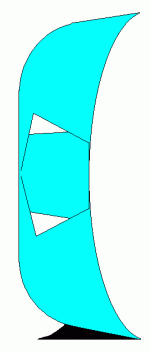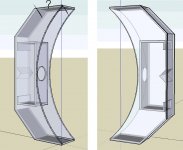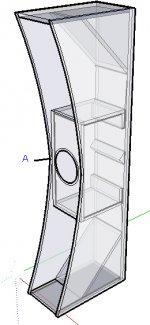I will build the Bruce and I'd love to incorporate a curved front. It's well worth the extra sheet of ply.
The centre section will be standard Bruce with the voids cut out.
The rear panel semi-barrel-staved using 8 or 9 ply pieces for each of the 90 degree bends - Kryten Bruce, not quite curvy.
FE207E with FT17H, Tweeter either on the main baffle or set back down the upper horn slightly with a thick felt star around it to reduce early reflections. Crossover or fullrange with a separate tweeter amp, not sure yet.
These curved cabinets look like they'll need some ballast to stand up without a rear leg. Sloping the top and bottom panels instead of parallel to the floor would create a void for some concrete. See my dodgy Paint sketch.
Construction is starting to get pretty complex but still on par with Ron's Dallas II. The sloping floor and top make it a completely different beast, It isn't really a Bruce any more.
The sloping top is a big plus for me... no ornaments or picture frames.
The centre section will be standard Bruce with the voids cut out.
The rear panel semi-barrel-staved using 8 or 9 ply pieces for each of the 90 degree bends - Kryten Bruce, not quite curvy.
FE207E with FT17H, Tweeter either on the main baffle or set back down the upper horn slightly with a thick felt star around it to reduce early reflections. Crossover or fullrange with a separate tweeter amp, not sure yet.
These curved cabinets look like they'll need some ballast to stand up without a rear leg. Sloping the top and bottom panels instead of parallel to the floor would create a void for some concrete. See my dodgy Paint sketch.
Construction is starting to get pretty complex but still on par with Ron's Dallas II. The sloping floor and top make it a completely different beast, It isn't really a Bruce any more.
The sloping top is a big plus for me... no ornaments or picture frames.
Attachments
OzMikeH said:Construction is starting to get pretty complex but still on par with Ron's Dallas II.
Well, if you have already built the DalasII you can always compare the two and share it with us
planet10 said:
oh my!, looks divine, should be rather simple to build, I will use the numbers from the original the Chang.pdf. Dave how far does the curve protrude? (I attached the file with the "?")
thanks, this is why I hang around this forum daily...
gychang
Attachments
I worked on this last night. The best balance/simplicity/hand off came in at 7.2" extension with an equal radius at the CL of the driver. Curve comes in at 1.1" from the baffle.
At this point you begin to get true horn action on the longer WL. as the WL gets shorter it is a WG. But the real cool response is the fact that all of the frequencies CL is directly centered.
Like i stated its a very very large FRD effect. As i moved the unit away from 1/4 space loading the response (pressure front) hardly changed. I believe this is due to the primary BR action with the large venting forward. Daves Dwg is just about right. I see little difference when the radius changes beyond this point. The 1.1" inset to the baffle is the best with the above radius. Without the curve the wavefront is collimated and un balanced over the rising frequencies. Again without the curve and with the extension there is a very nasty cavity resonance around 55 Hz to around 120 Hz. So the curve is necessary.
I may even build a set for myself. The looks of the cab is very modern and i can see a curved grill as looking excellent.
ron
At this point you begin to get true horn action on the longer WL. as the WL gets shorter it is a WG. But the real cool response is the fact that all of the frequencies CL is directly centered.
Like i stated its a very very large FRD effect. As i moved the unit away from 1/4 space loading the response (pressure front) hardly changed. I believe this is due to the primary BR action with the large venting forward. Daves Dwg is just about right. I see little difference when the radius changes beyond this point. The 1.1" inset to the baffle is the best with the above radius. Without the curve the wavefront is collimated and un balanced over the rising frequencies. Again without the curve and with the extension there is a very nasty cavity resonance around 55 Hz to around 120 Hz. So the curve is necessary.
I may even build a set for myself. The looks of the cab is very modern and i can see a curved grill as looking excellent.
ron
ronc said:I worked on this last night. The best balance/simplicity/hand off came in at 7.2" extension with an equal radius at the CL of the driver. Curve comes in at 1.1" from the baffle.
The 1.1" inset to the baffle is the best with the above radius. Without the curve the wavefront is collimated and un balanced over the rising frequencies. Again without the curve and with the extension there is a very nasty cavity resonance around 55 Hz to around 120 Hz. So the curve is necessary.
I may even build a set for myself. The looks of the cab is very modern and i can see a curved grill as looking excellent.
ron
Does the point A need to be recessed more?, 1.1"?
rough scatch with 7 1/4" extension.
gychang
Attachments
FlorianO said:Or, as Ron already hinted, extend forward even more the top/bottom to increase loading.
Now the $1000 question becomes "what is the optimal shape (type of curve, amount of forward extension, etc) that optimizes the loading for a particular driver". It seems that only a wizard with extensive simulation experience can answer that.
True, but the further you recess the driver, the more rolled off its HF will be due to the mouth's damping effect if you don't add a WG to shield it from the mouth's turbulance.
Well, going on theory, since the mouth is coupled to the floor it seems reasonable to me that the floor line would be center of the arc if you're concerned about 1/4 WL loading and the driver's centerline if 1/2 WL horn action, with the radius being a function of flare frequency of each.
I have no doubt that with a powerful enough program all these variables can be fine tuned to a fare-thee-well, though I doubt such possibly exists yet outside NASA or similar, but if you can visualize how different shapes/expansions affect a soap (sound) 'bubble' you can get close enough IMO since our acute hearing BW is very limited. A good thing too, otherwise we wouldn't be able to tolerate wide BW music or movie, etc., audio special effects except when either outdoors or in a ~aneochoic chamber.
ronc said:The additional factor is actually how many ppl would actually build this.
Now i can state this with assurance, with proper application and design, this basic effort by Scott can extend the performance of a singe FR cab by a fairly large amount over MLTLs or even some horn applications. And if done correctly will be a fairly simple,attractive build.
Yeah, I resemble this remark, I'm ~burned out on spending much time doing designs no one builds, or worse, builds them and doesn't give a review, warts and all, with whatever effort was required to tame them, or not, as the case may be.
I agree, I've periodically mentioned simple BVRs (even simpler than this one) and for a variety of technical or personal bias reasons been mostly ignored, or worse, but then I didn't back it up with fancy sims, cab dwgs, etc., so no one on the various forums until Scott was willing to gamble some time/$$ on one AFAIK. The trade-off is relatively poor transient response in its passband, but if tuned low enough it's not an issue except to those folks who 'listen' to sims, o-scopes, etc., or judge a speaker based solely on its alignment rather than how it reproduces recorded music in a typical room, a seriously flawed version of the live event in its own right.
GM said:
Yeah, I resemble this remark, I'm ~burned out on spending much time doing designs no one builds, or worse, builds them and doesn't give a review, warts and all, with whatever effort was required to tame them, or not, as the case may be.
I agree, I've periodically mentioned simple BVRs (even simpler than this one) and for a variety of technical or personal bias reasons been mostly ignored, or worse, but then I didn't back it up with fancy sims, cab dwgs, etc., so no one on the various forums until Scott was willing to gamble some time/$$ on one AFAIK. The trade-off is relatively poor transient response in its passband, but if tuned low enough it's not an issue except to those folks who 'listen' to sims, o-scopes, etc., or judge a speaker based solely on its alignment rather than how it reproduces recorded music in a typical room, a seriously flawed version of the live event in its own right.
I've been jacked up by the plain Harvey. And I've pretty much followed the GM path to enlightenment over the years-- building what Greg suggests for what I have.
I remember a cover story from Speakerbuilder where the guy made an array with a similar curve-- I guess so he could sit in the middle of a sphere of sound. What he found was that the only place the
build was listenable was in one small sweet spot. IOW extremely narrow soundstage.
Ye gods, I go into hospital for a day and a couple of dozen (very interesting) posts spring up. Love the CAD drawings guys & many thanks Ron for working out those curve dimensions & massively improving the basic design. (Go on Ron, you know you want to build a pair  ) With the curve in place, they should have a nicely art deco look.
) With the curve in place, they should have a nicely art deco look.
The Speaker Builder design was a focussed array IIRC. Only sensible way IMO to build an array with multiple FR units without resorting to massive Eq. I suspect the sweet spot of these would be a fair bit larger though -the curve is there for a different reason.
The Speaker Builder design was a focussed array IIRC. Only sensible way IMO to build an array with multiple FR units without resorting to massive Eq. I suspect the sweet spot of these would be a fair bit larger though -the curve is there for a different reason.
planet10 said:Dave's sketchup image of the curved enclosure in post #839
I can see a layertone version of this where the inner cabinet is oval shaped instead of a box and the walls are all curved. That would be something to see (and hear!) for sure.
The back on the Curvy Bruce is a diameter of 25 inches or 625mm.
I just looked at doing this curved back with pieces of 18mm ply.
Using 9 segments for each 90 degree bend use strips 57.5mm wide with both edges chamfered 5 degrees. (18 pieces for one cabinet)
Using 3 pieces for the bend use 176mm strips with 15 degree chamfers on both sides. (6 of these for one cabinet)
Errors in the chamfers will add up. I suggest gluing the curve together around a former.
The top, bottom and back will need to be reduced in length to butt against the ends of this curved part.
I just looked at doing this curved back with pieces of 18mm ply.
Using 9 segments for each 90 degree bend use strips 57.5mm wide with both edges chamfered 5 degrees. (18 pieces for one cabinet)
Using 3 pieces for the bend use 176mm strips with 15 degree chamfers on both sides. (6 of these for one cabinet)
Errors in the chamfers will add up. I suggest gluing the curve together around a former.
The top, bottom and back will need to be reduced in length to butt against the ends of this curved part.
Does this big curved front horn extension work well with the other Frugal Spawn cabinets too?
That is a case by case study. The energy is already there, all i have done is to focus it over a given BW while attempting to affect the higher frequencies at a minimum. Its the center mounted driver thats the trick here. Looking at the FR curve on the 207 i would still add a tweet for the higher frequencies, if you are still young enough to hear that high , i am not.
A basic rule of physical actions is you never gain or lose energy, only transform it.
ron
That is a case by case study. The energy is already there, all i have done is to focus it over a given BW while attempting to affect the higher frequencies at a minimum. Its the center mounted driver thats the trick here. Looking at the FR curve on the 207 i would still add a tweet for the higher frequencies, if you are still young enough to hear that high , i am not.
A basic rule of physical actions is you never gain or lose energy, only transform it.
ron
gychang said:Dave how far does the curve protrude?
That was with a 15" protusion & a 3/4" baffle inset
dave
That was with a 15" protusion & a 3/4" baffle inset
dave
Now this is the way it works. As the extensions go greater the BW of the LF response increases. Beyond 15 " extension there is little action. The radius point on the curve to the C/L of the driver cannot exceed the stated 1.1" as at that point the overlapping HF (1.2 Khz) wavefront is cancelled by the LF (37 Hz)wavefront That is to say that the pressures at a point in space(around 14" from the driver and (12" horz axis) are out of phase and cancellation occurs. This is the damping effect that Greg (GM) spoke of.
My modified 7.2" extensions and 1.1" depth from the radius curve to baffle appear to to be the best balanced configuration.
Yall have to look at this as a series of small varing explosions at different times and with different force, as the overlapping wavefront of the explosion occurs the timing of the explosions is critical if you want to hear all the explosions.
ron
dave
Now this is the way it works. As the extensions go greater the BW of the LF response increases. Beyond 15 " extension there is little action. The radius point on the curve to the C/L of the driver cannot exceed the stated 1.1" as at that point the overlapping HF (1.2 Khz) wavefront is cancelled by the LF (37 Hz)wavefront That is to say that the pressures at a point in space(around 14" from the driver and (12" horz axis) are out of phase and cancellation occurs. This is the damping effect that Greg (GM) spoke of.
My modified 7.2" extensions and 1.1" depth from the radius curve to baffle appear to to be the best balanced configuration.
Yall have to look at this as a series of small varing explosions at different times and with different force, as the overlapping wavefront of the explosion occurs the timing of the explosions is critical if you want to hear all the explosions.
ron
ronc said:Does this big curved front horn extension work well with the other Frugal Spawn cabinets too?
That is a case by case study. The energy is already there, all i have done is to focus it over a given BW while attempting to affect the higher frequencies at a minimum. Its the center mounted driver thats the trick here. Looking at the FR curve on the 207 i would still add a tweet for the higher frequencies, if you are still young enough to hear that high , i am not.
A basic rule of physical actions is you never gain or lose energy, only transform it.
ron
= Probably??
Bruce is similar overall dimension, same driver but the horn mouths are approx 1/3 larger and closer together. 7.25 inches may be too much.
yes I definitely need the supertweeter, either in a quadrant of the baffle or back in the upper horn to try to correct the time alignment.
I have no idea what a bruce is?
As the mouth area gets greater and the baffle area reduces there is a different radius and extension.
The whole idea is to combine the wavefronts centerline to a singular unit over as broad a BW as possible. That way it reacts as a very large FRD. Its just the opposite of a multi way with the drivers C/L far apart from each other.
ron
As the mouth area gets greater and the baffle area reduces there is a different radius and extension.
The whole idea is to combine the wavefronts centerline to a singular unit over as broad a BW as possible. That way it reacts as a very large FRD. Its just the opposite of a multi way with the drivers C/L far apart from each other.
ron
- Home
- Loudspeakers
- Full Range
- Spawn of Frugel-Horn


